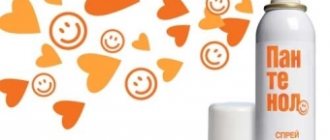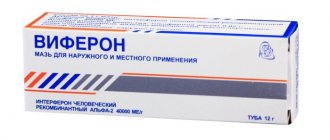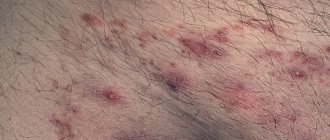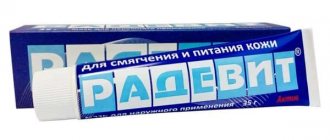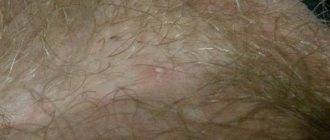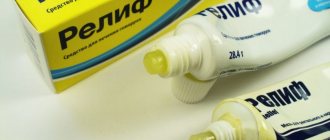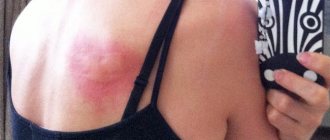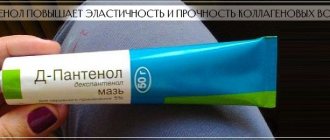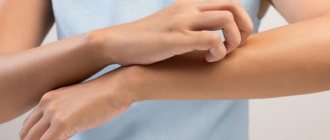Every home medicine cabinet should contain one or more wound healing products. And if it is enough to treat minor abrasions and scratches with hydrogen peroxide or iodine, then healing ointments will be required to treat more .
Photo 1. You need to choose an ointment depending on the type and degree of damage. Source: Flickr (kenga86)
Indications for the use of ointments for healing
The use of ointment medications is widespread in the treatment of any damage to the skin:
- Burns and frostbite.
- Scratches, abrasions, cuts.
- Purulent wounds.
- Cracks in the skin.
- Various manifestations of dermatosis.
Depending on the indications and main action, the entire variety of ointments can be divided into several categories:
- Regenerating . Used for healing abrasions, wounds, trophic ulcers, frostbite. Helps accelerate tissue recovery.
- Disinfectants (antiseptic). They disinfect the affected areas, creating a barrier against pathogenic bacteria.
- Anti-inflammatory . They are more often used for closed-type injuries - sprains, dislocations, etc.
- Antibiotic ointments . Effectively heal burns, purulent wounds, ulcers, and erosive lesions. Indicated in the postoperative period.
- Drying . Helps cope with weeping and purulent wounds.
It is important! Before using ointment preparations, the wound must be thoroughly washed, disinfected, and if necessary, stop the bleeding. After applying the ointment, the injured area is covered with a sterile bandage. All these manipulations can significantly speed up the recovery process and avoid possible complications.
List of ointments for wound healing
The list of drugs for wound healing is quite wide. Below are the most effective and popular means that have proven their effectiveness.
Solcoseryl
The main component of the drug is deproteinized dialysate obtained from the blood of cattle calves. Solcoseryl helps speed up metabolism in the epidermis, activate the formation of collagen fibers and enhance restoration processes.
The main area of application of the ointment is the treatment of ulcers (including trophic ones), bedsores, burns, and any other wounds. Solcoseryl is applied under a bandage and placed on a previously cleaned and dried wound. The standard frequency of use is 2 times a day.
Actovegin
In terms of composition, principle of action and cost, it is almost a complete analogue of Solcoseryl . Available in the form of a gel or ointment. The first option is more suitable for treating fresh wounds. After a few days of using the gel, the patient will most likely be advised to switch to the ointment form of the drug. In this case, the indications will be as follows:
- Light or deep cuts, scratches.
- Burns.
- Frostbite.
- Bedsores.
Contraindications include a tendency to edema, heart failure and individual intolerance to the components.
Eplan
The drug can help, first of all, those patients whose wound development is accompanied by infection. In addition to the bactericidal effect, it has a pronounced anti-inflammatory, restorative and analgesic effect.
Eplan can help not only in the fight against bacteria, but even against some strains of dangerous fungi.
The formula of the drug does not contain hormones or antibiotics , which allows it to be prescribed, including to children and expectant mothers.
Bepanten
A very effective and absolutely harmless remedy for the effective healing of any damage to the skin - from scratches to weeping wounds and chronic ulcers. The drug is created on the basis of dexpanthenol , which allows it to be used even by newborn children and pregnant women.
The ointment can be used for a long time without the danger of addiction or overdose.
Argosulfan
The silver ions present in the ointment make it possible to add a powerful antibacterial effect to the healing properties of the drug. Argosulfan will protect the wound surface from any infection, and in the case where infection is already present, it will stop reproduction and destroy pathogenic microflora.
The ointment has a hydrophilic base , providing an analgesic and moisturizing effect.
Excellent for the treatment of household injuries and damage to the skin caused by certain concomitant diseases: dermatitis, varicose veins, eczema, diabetes, etc.
Does the product retain its properties or not if the period of application has expired?
Let's consider how long the medication is valid after the expiration date and whether it can be used.
Most experts agree that using the medication after the expiration date is still permissible for at least six months , in some cases up to a year.
In 1979, FDA specialists together with the US military decided to find out. Research results have shown that 90% of all expired drugs remained effective and safe for human health for 5 and even 10 years after the expiration date.
Also, the AMA (American Medical Organization) conducted research in 2001, during which it was found that 88% of drugs do not lose their properties after the expiration date declared by the pharmaceutical company . Of the 3,000 drugs, 2,652 items did not lose their characteristics regarding safety and effectiveness for 66 months after the expiration of the declared shelf life.
What shelf life do medications have according to research results?
The organization published the following data:
- the named 88% of drugs retain their pharmacological properties for 5-25 years, provided the packaging is intact;
- the remaining 12% is partially destroyed, but 50-70% of the active substance remains in the drug - the medicine loses some of its beneficial properties, but does not become useless;
- Not a single medicine has such a high concentration of decomposed basic and auxiliary substances that would threaten human health and life.
Ointments for purulent wounds
If there are wounds with severe symptoms of an inflammatory process, accompanied by copious discharge of pus, the patient will be advised to use special ointments. The action of such drugs is aimed, first of all, at removing pus and necrotic masses from the wound, combating pathogenic bacteria and swelling.
Baneocin
This drug is based on two powerful antibiotics: bacitracin and neomycin . It will be effective for healing purulent wounds, burns, and preventing purulent complications. It is often recommended for use for dermatitis or eczema.
Ichthyol ointment
The drug acts simultaneously in several directions:
- Has an analgesic and bactericidal effect .
- Cleanses the wound from purulent masses.
- Has an antiseptic and anti-inflammatory effect.
- Accelerates metabolism and regeneration processes .
The ointment is applied to the problem area and covered with a dry sterile bandage. The dressing is changed twice a day. A noticeable improvement can be noticeable already on the second day of using the drug.
Levomekol
The ointment is indicated for use in all forms of purulent-inflammatory processes on the skin. Helps remove necrotic contents from the wound, prevents the spread of infection to surrounding healthy areas of the skin, and accelerates regeneration processes. The drug contains the antibiotic chloramphenicol and the powerful immunostimulant methyluracil.
The ointment is absolutely non-toxic, but can only be prescribed to small children and pregnant women by the attending physician.
Vishnevsky ointment
Treatment of purulent wounds in this case is carried out by increasing blood circulation in the tissues under the injured area. Necrotic masses are pulled out of the wound, and the additional anti-inflammatory, antiseptic and wound-healing effects of the drug contribute to the rapid restoration of damaged tissues.
The ointment is also applied under the bandage, which should be changed every 10-12 hours.
Negative consequences
The drug manufacturer cannot be held responsible for negative consequences when taking expired medications (what to do with expired medications from your home medicine cabinet?).
Let's name the possible consequences that can result from taking expired medications:
- food poisoning;
- increased side effects and complications of diseases;
- weak effect or its complete absence (this is especially dangerous when treating serious diseases).
Postoperative ointments and creams
As a rule, the patient is prescribed a drug that has an antibacterial, anti-inflammatory and wound-healing effect . Another important quality of postoperative drugs can be considered the ability to resolve scars. Among the relatively inexpensive ointments with a similar effect are:
- Heparin ointment.
- Dermatix.
- Alfogin.
Zinc-based preparations can show an excellent healing effect . They can quickly dry wet wounds and speed up the restoration of damaged tissue.
It is important! The choice of ointment to accelerate the healing of wounds formed after surgery should be made by the attending physician.
Method of using ointments
Each ointment, gel or cream for wound healing will have its own distinctive features in composition and method of application.
Photo 2. Before using the drug, you should always read the instructions. Source: Flickr (kenga86)
More often, the ointment preparation is applied in a thin layer under the bandage , on a previously cleaned and dried surface of the wound.
The frequency of changing the dressing can vary from 1 to 4 times a day , depending on the drug used and the intensity of the damage. Some ointments can be rubbed into the skin or applied as a compress on a sterile napkin.
Regardless of the drug chosen, it is important to adhere to the dosages and treatment periods specified in the prescription or doctor’s recommendations .
Many drugs in this group contain powerful antibiotics or antiseptics, the improper use of which can not only negate the entire therapeutic effect, but also cause some harm to the body.
Is it possible to take expired medications?
Some drugs remain effective even after 40 years.
Let’s say right away: it’s still worth getting rid of medications that have expired. The American Food and Drug Administration (FDA), for example, strongly recommends Don't Be Tempted to Use Expired Medicines. And there are a number of serious reasons for such a recommendation.
So, in some drugs, bacteria can begin to multiply over time. Others become dummies: you drink them, hoping for a cure, but the disease progresses. Still others change their chemical composition and generally turn into poison.
The FDA's arguments sound logical. However, the issue of expired medications is not as clear-cut as it seems. And that's why.
Contraindications for use
Of course, the best wound healing ointment is universal and can be used with equal effectiveness by any group of patients, including infants and pregnant women. Fortunately, there are many such drugs:
- Bepanten.
- Eplan.
- Panthenol.
Of the contraindications for such drugs, one can note only individual intolerance to individual components.
It is important! Antibiotic ointments should be used with caution, especially if they contain hormonal components. In any case, before using the drug, you should carefully study the instructions, and even better, consult a specialist.
Why expired medications are not necessarily bad
First, let's figure out what the expiration date is. This is the period of Drug Expiration Dates - Are Expired Drugs Still Safe to Take? , during which the pharmaceutical company that released a particular drug guarantees its safety and effectiveness. But determining the duration of this period is a very questionable matter.
The shelf life is generally determined as follows. Having released the next medicine, the manufacturer records its characteristics, including the chemical composition and concentration of active substances, and then puts the drug “on the shelf”. A year later, the composition of the drug is analyzed again and a conclusion is drawn about its effectiveness. Two years later, the analysis is repeated. And so on.
The problem is this: suppose the medicine has been “on the shelf” for three years. It cannot be released for sale without a specified expiration date. Expiration Dates - Questions and Answers. However, it is simply unprofitable for a pharmaceutical company to delay the start of sales. Therefore, the manufacturer indicates an already verified period as the expiration date - those same “3 years” - and with a clear conscience sends the drug to pharmacies.
In fact, the medicine can remain effective for more than three years. But the creators no longer check The Myth of Drug Expiration Dates.
Pharmaceutical companies are the only ones with the money to conduct long-term studies on the effectiveness of drugs. However, they have absolutely no financial incentive to do so. Does Medicine Really Expire? .
However, there are still departments that have a financial incentive to study the true shelf life of drugs. This is, for example, the US Department of Defense. In 1986, together with the FDA, it launched the Shelf-Life Extension Program (SLEP Expiration Dating Extension) to save on the costs associated with the need to renew drugs stored in stockpiles in case of emergencies.
The program regularly bears fruit. For example, in 2006, SLEP tested 122 different drugs stored under ideal conditions. Most of them ended up having their shelf life extended Stability Profiles of Drug Products Extended beyond Labeled Expiration Dates by about four years.
